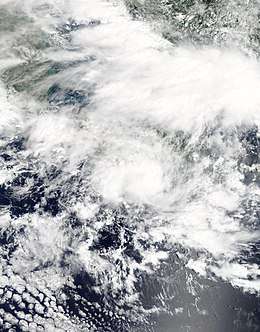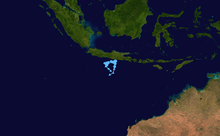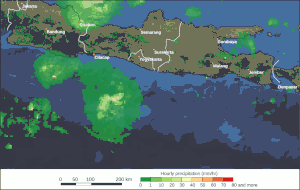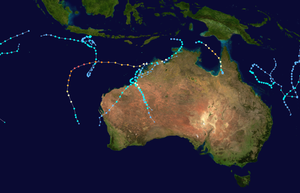Cyclone Cempaka
Tropical Cyclone Cempaka was a tropical cyclone that impacted the island of Java and Bali, Indonesia in November 2017. Although it did not make landfall and only developed to a category 1 cyclone, Cempaka managed to cause 41 deaths with more than 20,000 people evacuated and around US$83.6 millions in damages.[1][2] Cempaka was the fourth cyclone to be registered in Indonesia by the Tropical Cyclone Warning Center of the Indonesian Meteorology, Climatology, and Geophysical Agency (BMKG) since 2008 and the first since Cyclone Bakung in 2014. It also came closer to making landfall in that country than any other cyclone on record.[3]
| Category 1 tropical cyclone (Aus scale) | |
|---|---|
 Cempaka off the coast of East Java on 27 November | |
| Formed | November 22, 2017 |
| Dissipated | December 1, 2017 |
| (Remnant low after November 29, 2017) | |
| Highest winds | 10-minute sustained: 65 km/h (40 mph) |
| Lowest pressure | 998 hPa (mbar); 29.47 inHg |
| Fatalities | 41 total |
| Damage | $83.6 million (2017 USD) |
| Areas affected | Central Java, Special Region of Yogyakarta, East Java, Bali, Banten, West Java |
| Part of the 2017–18 Australian region cyclone season | |
Meteorological history

Cempaka initially developed as a weak tropical low around 332 km (206 mi) south of the city of Surabaya on 22 November as monitored by TCWC Perth and TCWC Jakarta.[4] At 06:00 UTC on 26 November, TCWC Jakarta recorded that the system was located 195 km (121 mi) southwest of the city of Cilacap as a tropical depression with a maximum wind speed of 45 km/h (30 mph). Wave heights of 2–4 m (7–13 ft) across the central and east southern coast of Java were predicted and a warning was issued.[5] A Tropical Cyclone Formation Alert was issued by the Joint Typhoon Warning Center the next morning on 27 November, stating that satellite imagery depicted flaring convection near the center of the system.[6] Several hours later, TCWC Jakarta upgraded the system to a tropical cyclone, giving the name Cempaka which was then located 100 km (62 mi) south-southeast of Cilacap.[7] BMKG warned of heavy rainfall across the island of Java with possible flooding and landslides.[3] On 29 November, Cempaka weakened into a tropical low and turned to the southwest away from Java.[8] It continued moving to the southwest on the following day.[9] TCWC Perth and Jakarta last mentioned Cempaka on 1 December.[10][11]
Impact

Cyclone Cempaka never made landfall but the rainfall it brought caused severe flooding and landslides across 28 regencies and cities in Java, mainly along the southern part of the island. Tornadoes were also reported in the area.[12] Pacitan received 383 mm (15.1 in) of rain on 27 November while Yogyakarta received 286 mm (11.3 in) on 28 November, both considered to be "extreme" amounts of daily rainfall by BMKG.[3] On 29 November, the government of Yogyakarta declared an emergency.[2] By 30 November, 26 deaths were reported and more than 14,000 people were evacuated in Central Java, East Java, and Yogyakarta according to the Indonesian National Board for Disaster Management (BNPB). Tens of thousands of houses and agricultural lands were flooded.[13] Roads were covered by landslides and bridges were destroyed in border regencies of Central Java and East Java, isolating some remote villages.[13] Indonesians and several politicians took into social media to express their condolences using the hashtag #PrayForPacitan. President Joko Widodo called the people to "remain vigilant" while relief efforts were being undertaken by the national and local government agencies.[12] The cyclone also changed the direction of ash from Agung Volcano in Bali from eastward toward Lombok to westward across Banyuwangi and Jember.[14] By early December, BNPB counted that at least 41 people were reported dead in Pacitan, Yogyakarta, Wonogiri, Purworejo, and Wonosobo. More than 28,000 were staying in shelters while the cost of the damages was estimated at Rp1.13 trillion (US$83.6 million).[1][2]
Rarity
The region of Indonesia is not generally traversed by tropical cyclones although a lot of systems have historically formed there.[15] Cyclone Cempaka was among the few tropical cyclones in the southern hemisphere which ever struck the region. An analysis of tropical cyclone data from the Bureau of Meteorology since 1907 to 2017 found that only around 0.62% of all cyclones in the Australian region during those years occurred north of the 10th parallel south.[16]
See also
- Cyclone Durga
- Cyclone Anggrek
- Cyclone Bakung
References
- "2.341 Kejadian Bencana, 377 Tewas dan 3,5 Juta Jiwa Mengungsi dan Menderita Akibat Bencana Tahun 2017" (in Indonesian). Badan Nasional Penanggulangan Bencana. 29 December 2017. Archived from the original on 15 January 2019. Retrieved 15 January 2019.
- "Cyclone Cempaka leaves at least 41 dead". The Jakarta Post. 6 December 2017. Retrieved 14 January 2019.
- "Siklon Tropis "CEMPAKA" Lahir, Siaga Cuaca Ekstrem 3 Hari Ke Depan" (in Indonesian). Badan Meteorologi Klimatologi Dan Geofisika. 27 November 2017. Retrieved 14 January 2019.
- "Tropical Cyclone Outlook for the Western Region for the period until midnight WST Saturday 25 November 2017". Australian Bureau of Meteorology. 22 November 2017. Archived from the original on 23 November 2017.
- "BULETIN INFORMASI SIKLON TROPIS Depresi Tropis 95S" (in Indonesian). Badan Meteorologi Klimatologi Dan Geofisika. 26 November 2017. Archived from the original on 26 November 2017.
- "Archived copy". Archived from the original on 27 November 2017. Retrieved 27 November 2017.CS1 maint: archived copy as title (link)
- "BULETIN INFORMASI SIKLON TROPIS Siklon Tropis CEMPAKA" (in Indonesian). Badan Meteorologi Klimatologi Dan Geofisika. 27 November 2017. Archived from the original on 27 November 2017.
- ""Cempaka" Meluruh, Siklon Tropis "DAHLIA" Lahir, Waspada Bencana Hidrometeorologi Menghadang" (in Indonesian). Badan Meteorologi Klimatologi Dan Geofisika. 27 November 2017. Retrieved 14 January 2019.
- "Tropical Cyclone Outlook for the Western Region for the period until midnight WST Sunday 3 December 2017". Australian Bureau of Meteorology. 30 November 2017. Archived from the original on 30 November 2017.
- "Tropical Cyclone Outlook for the Western Region for the period until midnight WST Monday 4 December 2017". 1 December 2017. Archived from the original on 1 December 2017.
- "TCWC Jakarta - Current Cyclone". Badan Meteorologi Klimatologi dan Geofisika. 1 December 2017. Archived from the original on 1 December 2017.
- "Banjir di Pacitan dan Yogyakarta, dampak 'keserakahan pada alam' dengan kerugian triliunan rupiah" (in Indonesian). BBC News Indonesia. 30 November 2017. Retrieved 14 January 2019.
- "Belasan Ribu Orang Mengungsi Akibat Siklon Cempaka" (in Indonesian). CNN Indonesia. 30 November 2017. Retrieved 15 January 2019.
- "Sebaran abu vulkanik terpengaruh siklon tropis Cempaka" (in Indonesian). Beritagar.id. 29 November 2017. Retrieved 15 January 2019.
- "Musim Siklon di Sekitar Indonesia" (in Indonesian). Badan Meteorologi Klimatologi dan Geofisika. Retrieved 15 January 2019.
- "Cempaka dan Dahlia, anomali siklon tropis Indonesia" (in Indonesian). Beritagar.id. 3 December 2017. Retrieved 15 January 2019.
External links
| Wikimedia Commons has media related to Cyclone Cempaka. |
- TCWC Jakarta - BMKG (in Indonesian)
